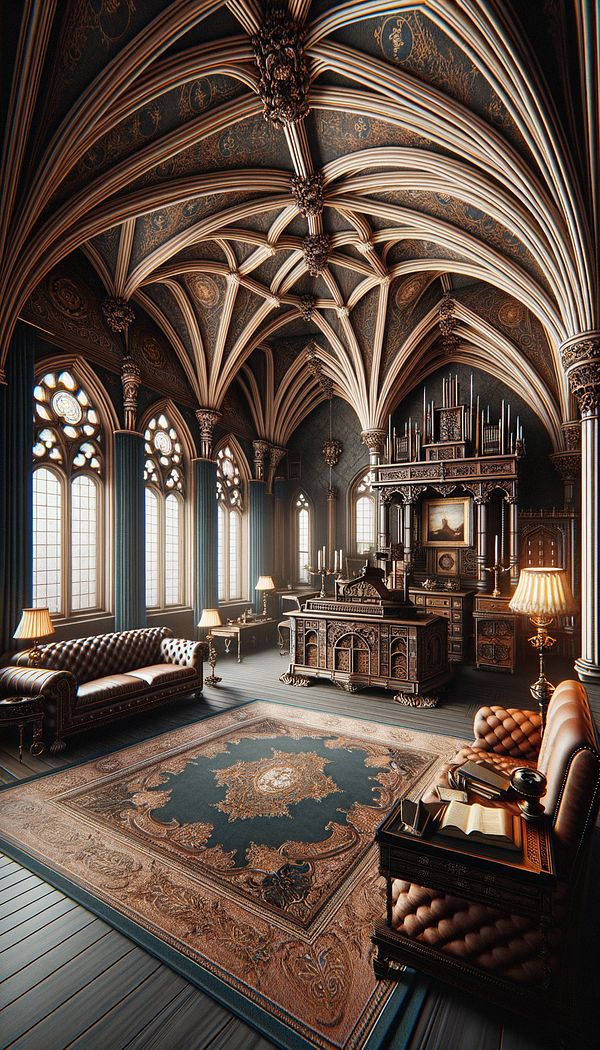What is Gothic?
Gothic refers to a style that is characterized by intricate designs, pointed arches, and a heavy emphasis on verticality and light.
Description
The Gothic style, originating in the 12th century, is most commonly associated with architecture but has significantly influenced interior design over the centuries. Characterized by its dramatic and ornate features, Gothic interior design embraces an aesthetic that is both grandiose and mystical. Key features of this style include pointed archways, elaborate detailing, high ceilings, and an emphasis on bringing light into spaces, often through large stained glass windows. This style often incorporates heavy, dark wooden furniture, wrought iron accents, and decorative patterns that draw inspiration from medieval, religious, and fantastical motifs.
The use of color in Gothic interiors tends to be rich and deep, with hues like burgundy, navy, forest green, and black predominating. Walls might be adorned with tapestries or richly patterned wallpapers that add to the overall opulence of the space. Lighting is another critical aspect, with candles, lanterns, or chandeliers featuring prominently to create a warm, ambient light that enhances the mystical and historical vibe of the design.
Incorporating Gothic elements into a modern home can breathe a sense of history, drama, and sophistication into the space. It's about striking a balance between the awe-inspiring aspects of Gothic architecture and the practical needs of contemporary living.
Usage
In interior design, Gothic influences can be seen in spaces that prioritize vertical lines and height, such as high-ceiling living rooms adorned with pointed arches or tall, narrow windows. Furniture often includes sturdy, carved wooden pieces and ornate, upholstered seating with rich textures. Decorative elements like stained glass, intricate ironwork, and heavy draperies contribute to the distinct Gothic atmosphere. This style is popular in themed restaurants, historical buildings, and homes where the owner wishes to make a bold statement.
FAQs
-
Can Gothic style be incorporated into a small space?
Yes, Gothic elements can be incorporated into a small space through the use of pointed arch designs, dark color palettes, and Gothic-inspired decorative items. It's about selecting key pieces that embody the style without overwhelming the space.
-
Is Gothic design only suitable for historical buildings?
No, Gothic design can be adapted to suit modern buildings as well. It's about incorporating key Gothic features such as pointed arches, decorative patterns, and an emphasis on verticality in a way that complements the contemporary architecture.
-
How can I add Gothic elements to my home without it looking overly dark?
To avoid a space looking overly dark, you can balance rich, dark colors with lighter hues and strategically use lighting to brighten the space. Adding mirrors and choosing lighter flooring or wall treatment can also help to diffuse light and add contrast.
Practical Application
To introduce Gothic elements into your interior design, start with iconic Gothic furniture pieces or architectural details such as arched bookcases or wrought iron light fixtures. Consider using rich, dark colors in your decor but balance them with lighter elements to avoid a gloomy atmosphere. Incorporating textiles like velvet or brocade in accessories can add a touch of Gothic opulence. Always aim for a harmonious blend of Gothic grandeur with modern comfort for a unique and inviting space.
-
Design Styles478 articles
-
Decorative Objects240 articles
-
Wall Treatments & Finishes157 articles
-
Historical Periods & Movements150 articles
-
Lighting Fixtures & Hardware17 articles
-
Statement PieceA bold, distinctive item that draws attention and sets the tone for a space.
-
Art DecoArt Deco is a design style characterized by bold geometric shapes, rich colors, and lavish ornamentation.
-
AntiqueA high-value item that is at least 100 years old.
-
LambrequinA lambrequin is a kind of decorative drapery or wood paneling that extends down the sides of a window or arch, often used in conjunction with curtains or blinds.
-
BarIn interior design, a bar refers to a counter and the surrounding area where beverages, either alcoholic or non-alcoholic, are prepared and served.
